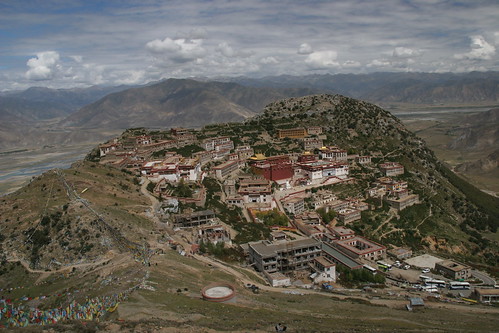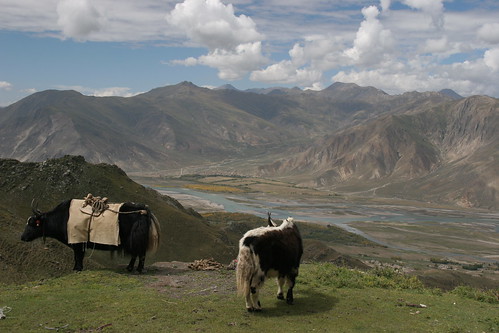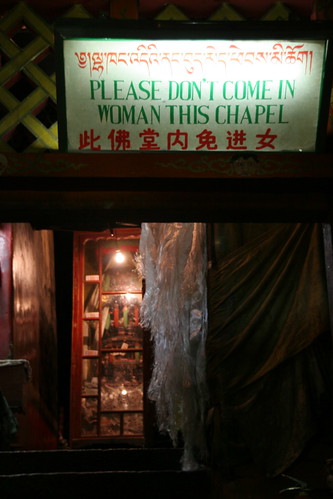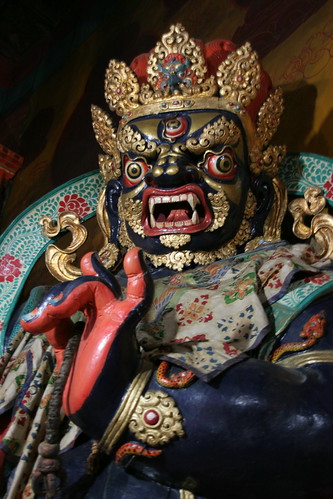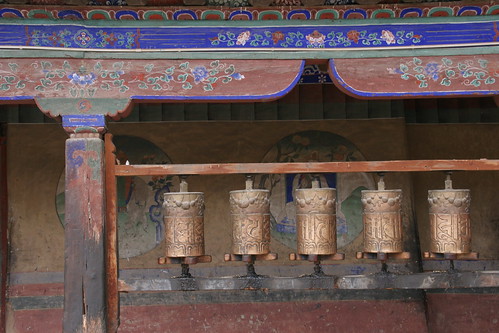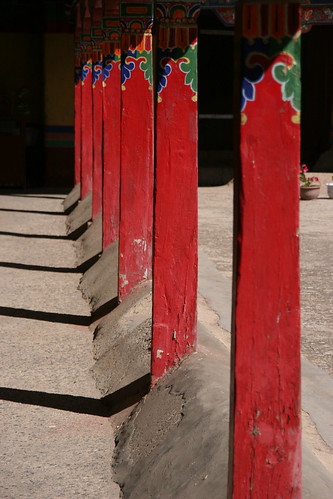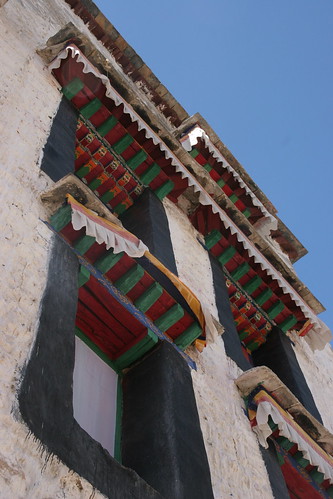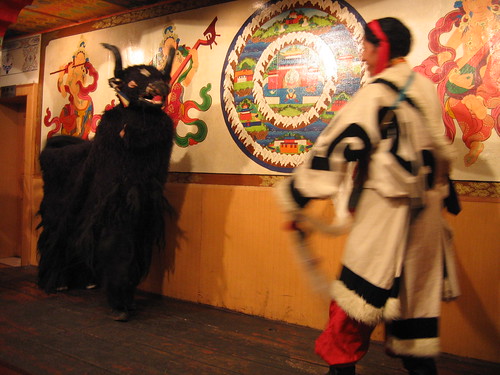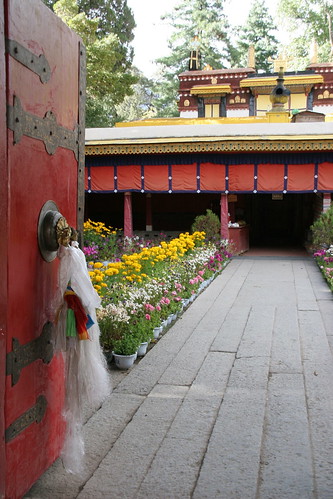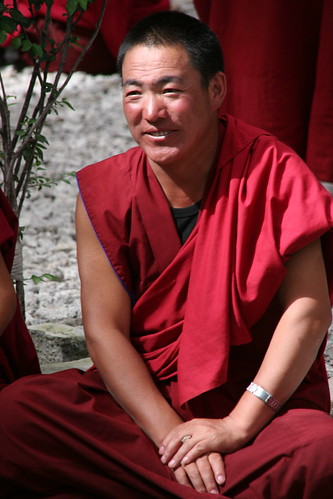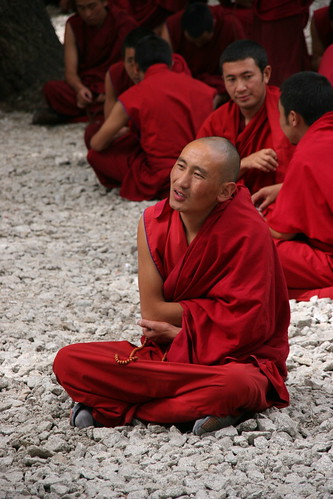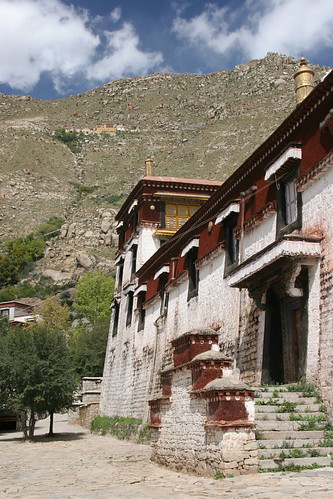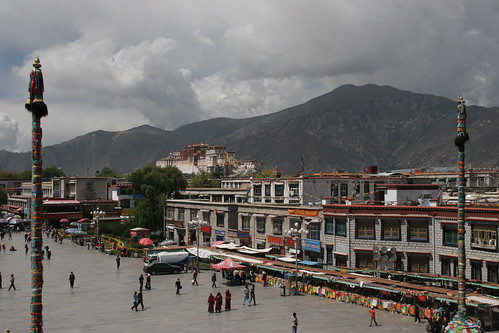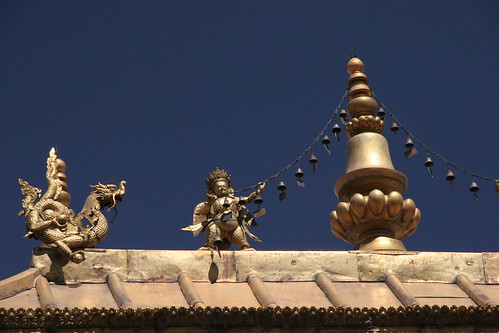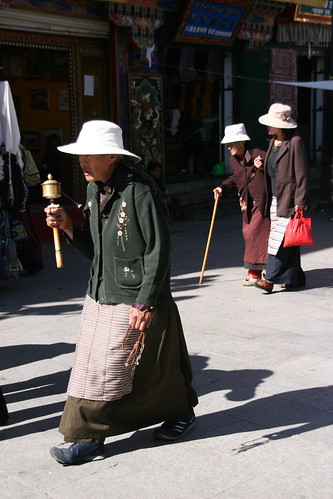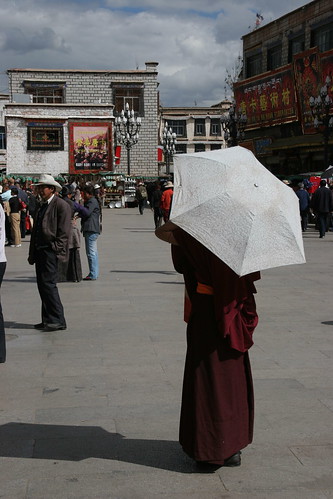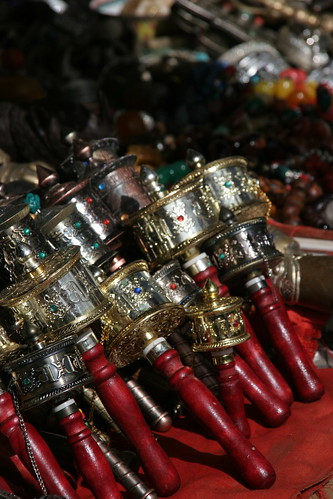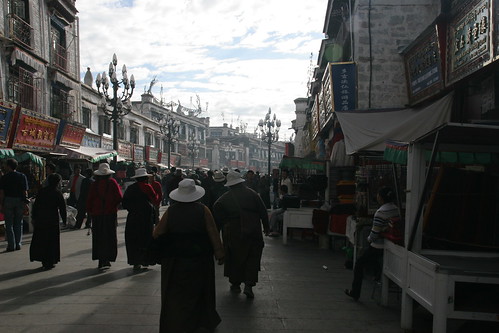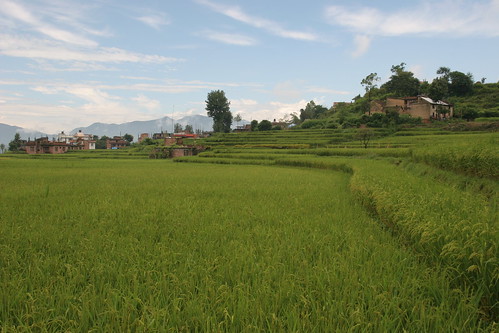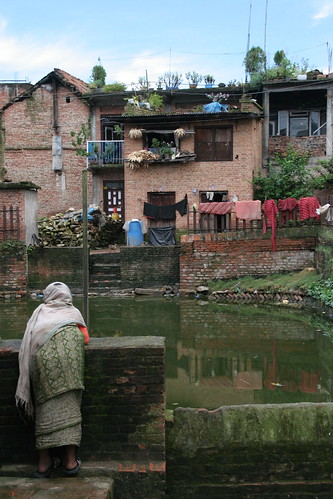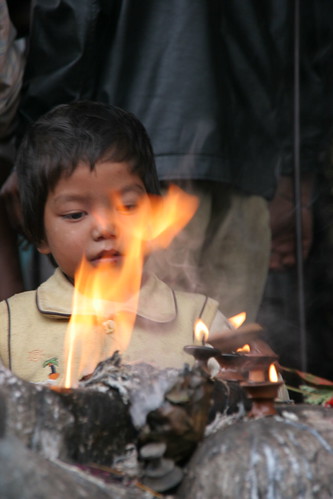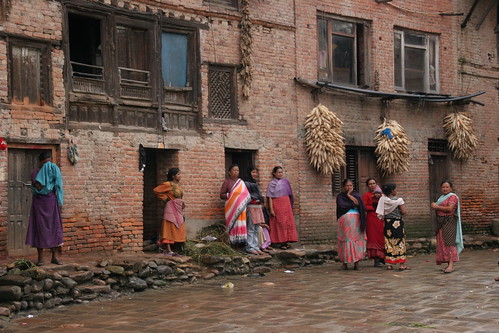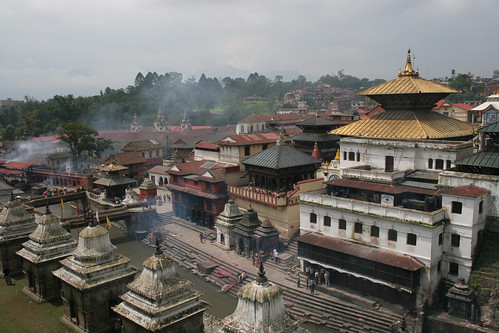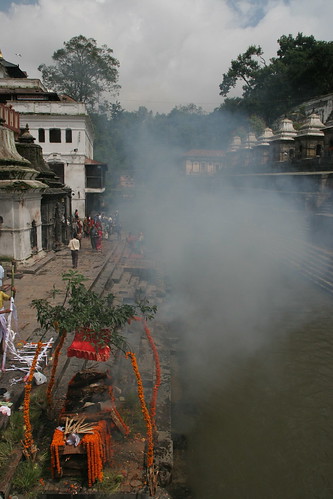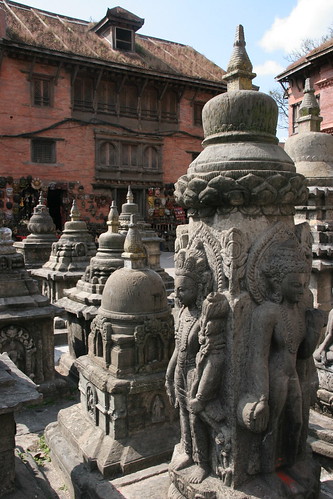Thursday, December 27, 2007
Ganden Monastery, Tibet
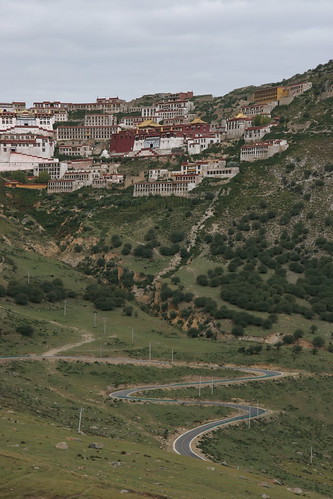
It's a one to two hour drive through stunning landscapes to Ganden Monastery which lies 40 kilometres north-east of Lhasa. The views are postcard-pretty - turquoise rivers, Himalayan peaks and yellow-green autumnal trees. The drive up to the moanstery involves half an hour of switch-backing along a steep mountain road. The nun we have picked up along the way asks us to stop so she can be sick.
Ganden Monastery lies at 4500 metres on a hillside overlooking the dramatic Kyi-Chi Valley. It was the first Gelugpa monastery and has been the main seat of this order ever since. Founded in 1409 Ganden means 'joyous' in Tibetan. Of all the great monasteries it suffered the most at the hands of the Red Guards.
The chapels are similar to other monasteries. The most impressive thing about Ganden is it's stunning location. There are 360 degree views of the valley and the Himalayans. I feel I'm on the roof of the world.
Drepung Monastery, Tibet
Eight kilometres outside Lhasa lies Drepung, the city's other great Gelugpa monastery. Over 10,000 monks lived here before the Cultural Revolution and Chinese takeover in 1951, making it the largest monastery in Tibet and one of the largest in the world. Only 600 monks live here now.
The word Drepung means 'rice heap' and refers to the large number of white monastic buildings piled up on the hillside. The buildings containing chapels and meditation halls are connected by steep staircases or wooden ladders. It takes some effort to reach them. Inside are gold Buddhas, thangpas, scriptures and lacquered walls. Photography is allowed here but for a charge of about 20 Yuan for each chapel.
The huge scale of the monastery means it takes at least three to four hours to visit the main areas. A few nuns live around the monastery. Our guide takes us into the humble house of one of them. She has a photo of the Dalai Lama hidden under a veil.
Norbulingka, Lhasa, Tibet
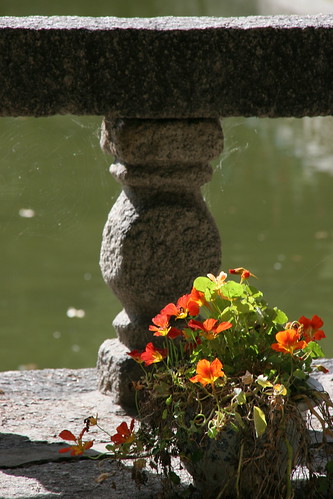
After lunch at the Yeti Cafe I decide to visit Norbulingka, the summer palace of the Dalai Lamas founded in 1755 by the Seventh Dalai Lama.
Norbulinga means 'jewel park' and is a sprawling complex of gardens and palaces which incorporates the New Summer Palace and the Palace of the Eighth Dalai Lama. I found none of the palaces particularly impressive, not least because many of the rooms are closed to the public, though a great effort has been made to maintain the gardens which are lovely and colourful.
Potala Palace, Lhasa, Tibet

The building is of such mammoth proportions it's difficult to know where you are. Climbing the labyrinthine staircases I emerge on the roof of the White Palace, which were the private rooms of the 13th and 14th Dalai Lamas.
Across the roof is the entrance to the 3rd floor of the Red Palace. I walk through a series of dark chapels which include the jewel-encrusted tombs of the Eighth and Ninth Dalai Lamas and glass showcases of Buddha images, mandalas, thrones and statues.
Descending to the second floor leads me to more temples. The first floor is closed but then the highlight for me is the Chapel of the Dalai Lamas Tombs on the ground floor. The room is dominated by the huge 12.6 metre-high chorten of the Fifth Dalai Lama (who built the Potala Palace) gilded with 3700kg of gold. On the left and right of him are two smaller chortens containing the Tenth and Twelfth Dalai Lamas, who both died as children.
It take me an hour and a half to walk through. By the end of my visit I'm feeling nauseous from the smell of the yak butter candles in every room.
Potala Palace, Lhasa, Tibet
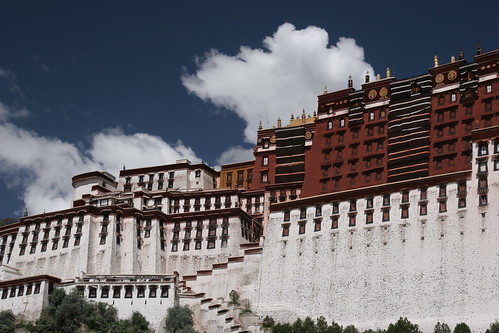
Our guide had queued up for our entry tickets yesterday. We have a tight time slot so cannot dilly- dally. No photography is allowed inside the Palace and there are cameras in every room watching.
It's another steep climb to the entrance along wide steps. I'm out of breath by the time I reach the entrance. It's a place of massive proportions. There are 1000 rooms, although only 70-odd are open to the public.
It used to be the winter palace of the Dalai Lamas until the Dalai Lama was forced to flee. It now has no official purpose and is effectively a huge museum filled with groups of Chinese tourists, which is ironic considering they tried so hard to destroy it.
Sunday, December 09, 2007
Potala Palace, Lhasa, Tibet
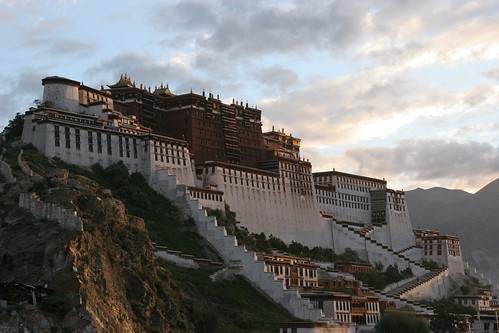
It's my third day in Lhasa and I still haven't adjusted to the altitude. I've been having crazy adrenalin-fuelled dreams (which continued throughout my whole time in Tibet) and nursing a constant headache.
Even so I don't want to miss out on Lhasa so I'm up at dawn to catch sunrise over the Potala Palace. Climbing a small stupa across the road for a charge of two Yuan I join a bunch of tripod-wielding Chinese camera enthusiasts jostling for the best angles. Sunrise isn't spectacular in the traditional sense as it's cloudy and dark but it gives the Palace a brooding, gothic feel as it looms over the city.
Sera Monastery, Tibet
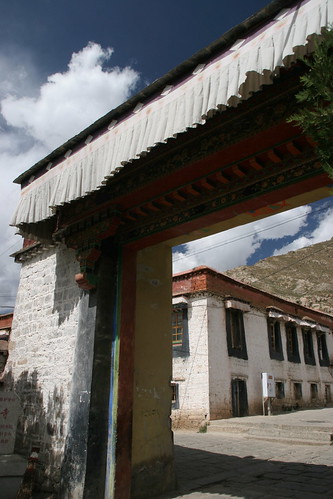
Five kilometres north of central Lhasa is Sera Monastery, one of Lhasa's two great Gelugpa monasteries (the other being Drepung). It was once home to 5000 monks. Today it houses just 250.
The monastery is a self-contained complex with its own cobbled streets and white-washed buildings. Every now and again a red-orange robed monk appears and just as quickly disappears down an alley.
The highlight of the monastery is the Debating Courtyard where tourists are allowed between 3 and 5pm. Inside the walls, clusters of monks sit in shady corners, under trees debating various issues. A facilitating monk asks questions and responds to the answers by slapping his hand. Some of the monks look animated, others look bored. As I don't understand the language it's difficult to know whether they are discussing philosophy or what they are having for dinner tonight. Even so it's a colourful spectacle.
Jokhang Temple, Lhasa, Tibet
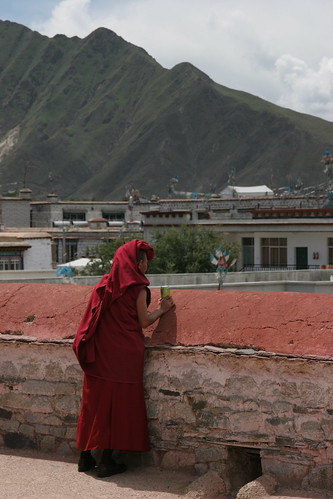
There are video cameras poised over Jokhang Square watching the moves of Tibetans. I remember at the internet cafe I went to last night I couldn't access my blog or the BBC, other news sites or even Hotmail, but put it down to a lousy connection. This is the worst censorship and repression I have ever come across.
Jokhang Temple, Lhasa, Tibet
The Chinese brutality doesn't end there. In 1995 the Dalai Lama identified Gedhun Choekyi Nyima, a six-year-old boy, as the 11th Panchen Lama. Within a month the Chinese had abducted him and ordered senior lamas to come up with the second, Chinese-approved choice. Beijing's interest in controlling the appointment of the Panchen Lama is in the fact that he may be influential in identifying the future reincarnation of the Dalai Lama. I asked some Tibetan pilgrims what they though of the current Chinese-appointed Panchen Lama, many see as a government puppet. They unanimously said he was not the 'real' one and had no respect for him.
Meanwhile the youngest political prisoner in the world is still under house arrest somewhere in China. There are groups campaigning for his release:
www.atc.org.au
Sign the petition - http://gopetition.com/petitions/release-the-kidnapped-panchen-lama-of-tibet-gedun-choekyi-nyima.html
http://en.wikipedia.org/wiki/Gedhun_Choekyi_Nyima or read 'In search for the Panchen Lama' by Isabel Hilton
Free Tibet http://www.freetibet.org/
http://www.studentsforafreetibet.org/
Meanwhile the youngest political prisoner in the world is still under house arrest somewhere in China. There are groups campaigning for his release:
www.atc.org.au
Sign the petition - http://gopetition.com/petitions/release-the-kidnapped-panchen-lama-of-tibet-gedun-choekyi-nyima.html
http://en.wikipedia.org/wiki/Gedhun_Choekyi_Nyima or read 'In search for the Panchen Lama' by Isabel Hilton
Free Tibet http://www.freetibet.org/
http://www.studentsforafreetibet.org/
Jokhang Temple, Lhasa, Tibet
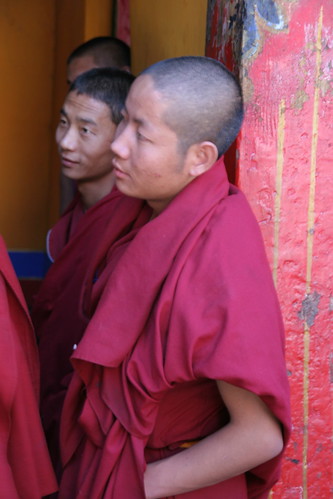
The Jokhang was originally founded in 639-647 AD. Inside the main area are six larger-than-life statues of various Buddha incarnations. There is also a photo of the 10th Panchen Lama, the number two-spirtual leader after the Dalai Lama, and a hero of Tibet. There are photos of the Panchen Lama wherever you go in Tibet.
The reverence for the 10th Panchen Lama comes from his stand against Mao Zedong, refusing to denounce the Dalai Lama and going as far as asking him to 'liberate' Tibet after presenting him with a catalogue of the atrocities committed by the Chinese. This was a kick in the teeth to the Chinese who endorsed his appointment.
The Chinese responded by throwing him in jail for 14 years and torturing him. Many Tibetans believe he was poisoned by the Chinese on his release and didn't die of a heart attack as reported.
Barkhor Circuit, Lhasa, Tibet
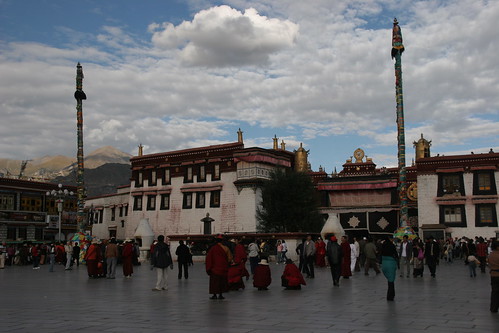
My tour group is staying in Lhasa for a few days to acclimatize before we head to higher ground. I'm thankful for this as I do not sleep well and am still suffering the effects of altitude.
Last night some of the group talked about getting up early to watch sunrise over the Potala Palace. I would love to see that but today I don't feel well and sleep until 10.30.
A few blocks away from my hotel, the Tibetan-style Banakshol, is the Barkhor Circuit, trodden by hundreds of pilgrims every day. At the heart of the Barkhor, which is also home to a bustling local and tourist market, is the Jokhang Temple, the most revered religious structure in Tibet.
(Photo - Jokhang Temple, Jokhang Sqaure)
Lhasa, Tibet
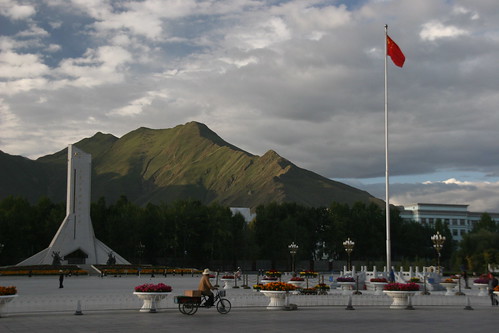
Lhasa is divided into the Chinese quarter and the Tibetan quarter. I'm staying in the Tibetan part of the city which seems less glitzy and westernised than the the rest.
The city is 3700 metres above sea level. By the evening I have a thumping headache and am having trouble breathing, even though I have been drinking copious amounts of water. I'm forced to abandon my yak steak at Dunya restaurant, take some painkillers and go to bed.
Tibet
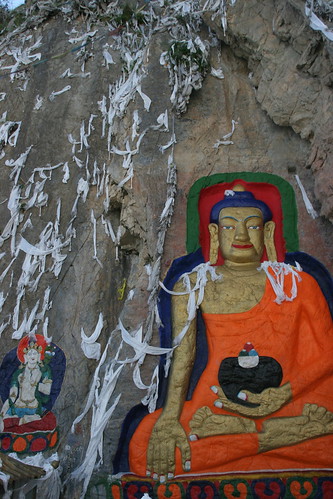
I emerge from Gongkar airport to a view of high mountains. It's sunny but the air is incredibly dry. I know this because my hair hasn't frizzed freakishly as it did in Kathmandu. Lhasa is a 55-kilometre drive through a barren landscape. There is hardly a soul to be seen. Just rivers, bare mountains and endless skies.
The bus stops off at a Buddha monument covered in white prayer scarves. The higher the scarf is placed, the better the next life will be.
As we drive into the capital Lhasa, the Potala Palace takes my breath away. I've read how utterly awe-inspiring it was, but I'm still not prepared for this. Sitting on top of the Red Hill its intimidating presence looms overs the city like a sentinel.
(Photo - prayer scarves and Buddha monument)
To Tibet

I'm flying to Tibet today and I can't wait. I've joined a tour group as the Chinese have made it difficult and expensive to travel independently beyond the capital, Lhasa.
I'm really excited about Tibet. Ever since a friend conjured up images of vast, desolate landscapes and monasteries perched on top of mountains I haven't been able to dispel the dream of visiting. So much so that when I arrived in New Zealand I changed my travel plans and booked a flight and tour for three months later.
I'm advised to leave my valuables in the hotel in Kathmandu as baggage handling between Kathmandu and Tibet isn't the most secure. At Kathmandu airport I seem to go through endless security checks even though these are half-hearted. The guard rummages through the top section of my bag intrigued by a sanitary towel but not at all interested in the contents at the bottom of my bag.
The flight to Lhasa takes just under an hour and passes through dramatic mountain scenery. Everest is pointed out to me as a peak as high as the aircraft. It's a strange sensation to be flying at the same height as a mountain.
Sunday, November 18, 2007
Patan, Kathmandu, Nepal

I learn there are several Durbar Squares in Kathmandu. The one in Patan is more picturesque and less crowded than the one near Thamel.
A bright young boy tries to sell me a silk purse. I'm impressed by his English and ask how old he is. He says 'thirteen, maybe fifteen', although he looks much younger. I ask if he goes to school but he tells me he can't afford it and has to support his family who aren't able to work. He's incredibly sharp. It seems a shame for him to be denied an education. I know this is the same story for a million children around the world. He shows me around the square. I buy all his bags which comes to the huge sum of GBP 1.50 and say goodbye. Somehow I don't want to leave him here.
(Durbur Square in Patan)
Kathmandu Valley, Nepal

I'm looking forward to escaping the dust and noise of Kathmandu. The rain this morning has cooled the city down a little.
It's an hour's drive to the adjoining villages of Bungamati and Khokana in Kathmandu Valley. They're steeped in lush rice fields and flanked by high mountains. Walking down the muddy streets that look medieval, I feel transported back in time. The local Newar people are taking hand baths on the streets as there's no running water here. People, chickens, lambs, goats and dogs flood fill the streets and square creating a colourful spectacle.
Sunday, November 11, 2007
Pashupatinath, Kathmandu, Nepal
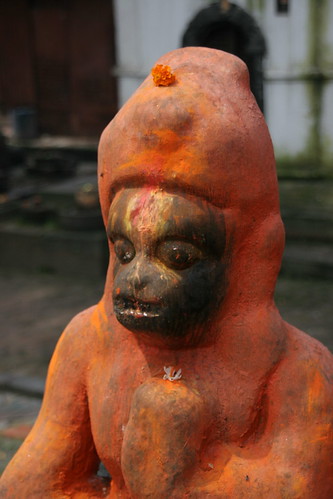
Last night I was bitten again badly, this time on the eyelid which has become grotesquely swollen. Aside from being slightly repulsed at my appearance, the hotel staff insist on my changing rooms. I've noticing lingering stares in the lobby so I decide to wear my sunglasses even though it's overcast and raining. I feel like an idiot.
I take a taxi a few kilometres east of the city to Pashupatinath, the most sacred Hindu site in Kathmandu set along the steps of the Bagmati River. I've only taken a few steps when a would-be guide latches on to me and offers to show me around. By the river there are several stone plinths crowned with funeral pyres. The guide shows me some feet protruding from a smoking pile of wood. I hadn't noticed this and would have happily remained ignorant. He tells me on average 40-50 people (80% of the population is Hindu) are cremated a day. I look along the river and see several other burning pyres. There are also houses where the old and infirm, with no hope of a cure, are brought to die.
The guide takes me aside and asks me to give him his tip in private. He says that if other guides see me tipping him, they will demand a proportion of the money.
Subscribe to:
Posts (Atom)
